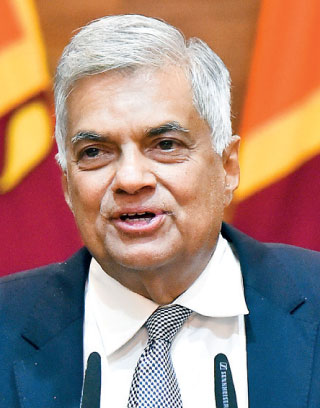Saturday Dec 14, 2024
Saturday Dec 14, 2024
Monday, 22 August 2022 00:18 - - {{hitsCtrl.values.hits}}

President Ranil Wickremesinghe

Central Bank Governor Dr. Nandalal Weerasinghe

Treasury Secretary Mahinda Siriwardena
By Manjuka Fernandopulle
What is happening with the debt restructuring process? Three concepts are in play. First is the Debt Sustainability Analysis (DSA). It estimates the resources available to repay the debt. Basically, it looks at how the debt to GDP ratio can be brought down. It also informs the creditors of the debtor nation’s resources to pay the restructured debt.
The variables calculated are GDP growth assumptions, revenue, and expenditure in the context of different scenarios. There is a contention as to growth rate assumptions. There is a theory of what is called the debt overhang effect on GDP growth. Studies have shown that sovereign debt defaults have an overhang effect on economic recovery and thus previous assumptions as to the behaviour of the economy no longer hold true. However, this may or not be applicable in the case of the Sri Lankan economy given the resilience it has shown in recovering from past crises.
However, one must be mindful that this is Sri Lanka’s first sovereign default. The ghost of this default will linger on. The assumption that Sri Lanka will be bailed out or act in a rational manner to avoid an economic meltdown may no longer be taken to be true or even factored in when risk calculations are done for when investor decisions are made. It is estimated that 2022 and 2023 will have negative economic growth close to minus 10%. This will result in the Debt to GDP increasing from the present 114%.
Second is the IMF’s lending into arrears policy. The policy spells out the rules as to how and when the IMF can lend when there is a sovereign debt default. It requires the debtor country to show that there is a good faith attempt to negotiate and the IMF must be satisfied with the financing it is providing despite the default it would not harm its ability to provide finances if a contingency does arise. In terms of this policy, if there are arrears due to the IMF and the World Bank, the IMF does not provide financing until the arrears are settled.
Generally, if the debtor country does not have sufficient resources to settle the official lender arrears, a bilateral lender would extend a bridging loan to settle the outstanding arrears. This happened in Sudan’s debtor restructure that was concluded last year where France extended a $ 1.5 billion loan to pay outstanding official arrears. The loan was repaid when Sudan accessed the IMF funding. The IMF will look to the consent of bilateral debtors to ascertain whether there is a good faith negotiation. The IMF takes a somewhat liberal approach in applying the policy to commercial creditors but will ensure its funds are not used to bail them out. The policy arises from the contents of Article VI of the IMF articles of agreement.
The third is the indicative debt scenarios being prepared by the financial advisors. This is where the debt country spells out the quantum of debt relief sought and the methods the debt relief will be conveyed. The debt relief will be calculated in terms of net present value.
Methods of relief are maturity haircuts, coupon adjustments, or maturity extensions. For maturity hairs to occur the creditors may insist on some sort of value recovery mechanism so that they can gain on the lost capital if there is an upside in the debtor economy.
The indicative ‘debt sicario’ is akin to the sovereign debtor’s wish list. It is what it wants but not necessarily what it gets. The publishing of the indicative debt scenarios signals the formal start of the debt restructuring negotiations. Indicative debt scenarios are generally published on a website to ensure full disclosure in compliance with US securities regulations.
What the tough negotiations would be about is how much foreign debt creditors are willing to subsidise domestic creditors to deliver debt relief to Sri Lanka.
The foreign debt mix in Sri Lanka is complicated. It consists of bond debt, multilateral loans, bilateral loans, and bank loans. The bank loans and bond debt are considered.
From what I gleaned from my exchanges with the bondholders’ advisors, I believe they are going to push for domestic restructuring. The domestic quantum of domestic currency is around $ 50 billion. They will want the burden of debt relief shared by the domestic creditors. They believe that given the quantum of the domestic debt a sustainable solution could only be found if the domestic debt is also treated.
They will also insist on transparency in negotiations. This means they will insist on full disclosure of what is being offered to the Chinese and the principle of comparable treatment applied as the operative foundation of the debt restructure. Comparable treatment ensures inter-creditor equity or that all creditors take on the equal burden of providing debt relief and no group of creditors or creditors subsidise repayment of debt of another creditor by providing debt relief.
Most likely, the Chinese are going to insist on confidentiality and preferred status. The Japanese will insist on the Paris club terms applying to the restructuring of Chinese debt. The bondholder’s committee is advised by White and Case and Rothschilds. The White and Case sovereign debt restructuring practice is led by Ian Clark. Ian Clark is a veteran restructuring lawyer. He has been involved either on the sovereign side or the creditor side in every sovereign restructure that took place in the last thirty years. He is currently advising Zambia, Suriname, and Ukraine. In Zambia and Suriname, he is assisted by Lazard as a financial advisor. In Suriname, bilateral creditors include both India and China. The creditors have been offered oil price-linked value recovery instruments.
Ian’s philosophy is that one must not miss the wood for the trees. Therefore, it is my perception that he will be looking at the larger picture as opposed to the granular. For him, it will be all about creating an efficient economy that ensures value recovery for his clients’ outstanding debts. Thus, I believe he will take the best approach that will secure his clients’ payments whilst not inflicting unnecessary pain on the domestic economy.
It was this philosophy that he applied along with Bruno Cuiffettelli of Hogan Lovells to successfully complete Ecuador’s debt restructure in six months with an exit yield of 8-10%. Ecuador is a major oil producer and dollarised economy but a serial defaulter. The need for domestic restructure was avoided in Ecuador. Hogan Lovells successfully prevailed over a holdout creditor challenge in the New York
District Court of the Southern District.
Ian also advised the bondholder committee in Lebanon and the creditors in Iceland, Cyprus, and Greece. He has the insight, experience, and ability to show how bail-ins can be used to successfully ensure that creditors will get priority in payment whilst securing the financial stability of the domestic financial system. He is essentially advising the same set of clients he advised in Argentine, Ecuador, and Lebanon.
(The writer holds an LLM (University of Notre Dame, USA), LLM (University of Auckland), LLM (University of Colombo), LLB (Hons) (Hull) and is a lawyer with multi-jurisdictional qualifications in Law of International Finance and Sovereign Debt, International Commercial and Investment Arbitration, International Tax and Australian Corporate Restructuring and Insolvency, International Law, and International Human Rights law with multifaceted professional skills and experience.)